8th June 2017
An oil products tanker, empty and high in the water, speeds up the River Hull as the Drypool bridge begins to lift – when fully raised it is only a little short of vertical. Drypool Bridge, built in 1961 to replace an earlier swing bridge, is a Scherzer rolling lift bridge. Patented by William Scherzer in the US in 1893, two months before his early death at only 35, US Patent 511,713 describes the principle clearly:
“A lift-bridge having a moveable span provided at one end with a curved part adapted to rest and roll upon a stationary supporting surface. Other characteristics noted in the patent include: teeth or projections on the said curved part adapted to interlock with projections on the supporting surface to hold the said curved part from moving or slipping on said surface; and means for moving the span, comprising a horizontally moving part connected with the span at or near the central point of said segmental or sector-shaped part.”
This design takes up little space and by rolling backwards away from the river it leaves this entirely clear for navigation. With the weight of the bridge being balanced by a heavy counterweight at its rear, relatively little energy is needed to raise the bridge. It was a remarkably simple and elegant invention.
As a part of the celebrations in Hull’s year as City of Culture, Drypool Bridge has recently been repainted from its rather plain blue (enlivened by a little rust) to a pattern celebrating Victorian mathematician John Venn (1834-1923), born in Drypool where his father was rector. He moved away from Hull when he was seven and attended schools in north London before going to Cambridge. So far as I’m aware he had no further connection with Hull. But the bridge does look quite pretty in the pictures I’ve seen of it.
I’ve not been able to find any information about MV Mister Humber moored in the foreground. The two barges in the distance are Poem24 and Kago.
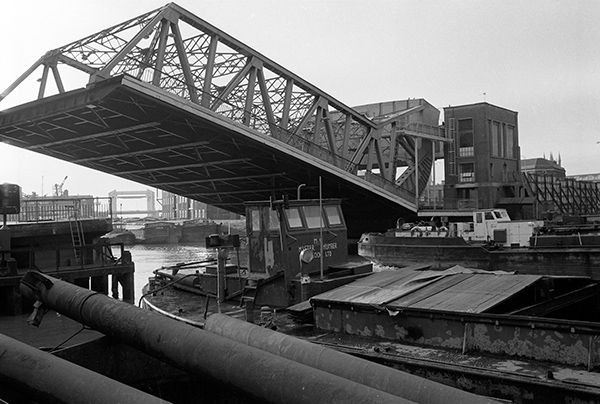
33h13: Drypool Bridge raised for traffic on the River Hull, 1982 – River Hull
9th June 2017
The shadow on the wall at the right of this picture is of the gate into Mandela Gardens, leading now to the StreetLife Museum. The warehouses at left, 172 High St, have been converted into flats but still look rather run down. It’s a little difficult to recognise them as the bricks have been covered, but the large central blocked doorways at ground and second floor level are still there, though windows have been added on the first and second floors.
George Yard, then a pedestrian way only, marked by a post to stop vehicles has now been widened and renamed Gandhi Way, and there is a bust of him in Mandela Gardens, unveiled in 2004, donated by Hull’s Indian community, behind the wall on the right of the picture.
John Wesley preached at the new Methodist Chapel in George Yard in 1788 on one of his many visits to Hull (the first in 1752 ended in a riot) more or less opposite Wilberforce House on the other side of High St. But by that date William Wilberforce had left Hull to live in London, and it is unlikely that the young Wilberforce had been allowed to go and hear this powerful preacher against slavery on any of his earlier visits as his mother was strongly opposed to Methodism – and brought him back to Hull from London when he was 12 in 1771 fearing he might be influenced by Methodist friends of the relatives he was living with, and sent him to school in Pocklington to avoid Hull Grammar’s Methodist headmaster.
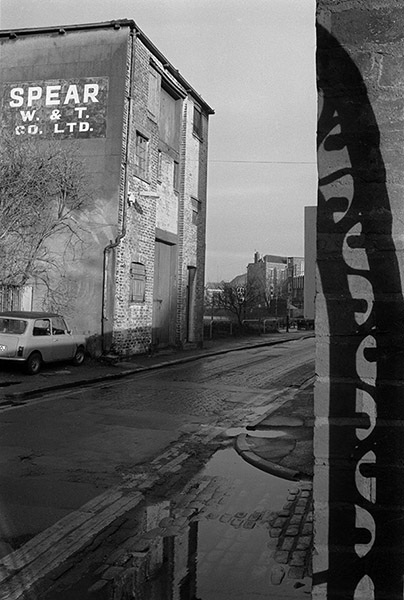
33h23: Dereliect warehouse, High St, 1982 – Old Town
10th June 2017
E E Sharp & Sons Ltd at 158/9 High St, were, according to the notice on their doorpost, ‘Dealers in Ships Bonded Stores, Ship Chandlers, Sail Makers etc’.
The business was founded here in 1868. Mr William Rayment, born in 1829 was from 1875 a member of Hull council and an Alderman for Coltman St Ward from 1886 and Mr E T Sharp died in 1921. As well as the High Street premises, they also had offices in Bond St. The High Street premises were reported as being badly damaged by a fire in 1907. In 1911 they are listed as General Agricultural Merchants and Manufacturers. In 1932 the Hull Daily Mail published a notice of the voluntary liquidation of Rayment Sharp Ltd, and its purchase from the Receiver in 1932 by EE Sharp Ltd.
The window and door and the names from the ground floor have gone, and the front of the building is now a solicitors, with a wide entry through the centre to ‘The Sailmakers Arms’ pub. I can’t vouch for it but it is supposed to serve good pies and decent beer. Rather surprisingly it was selected as one of five ‘historic’ Hull pubs by the community arts group, Cascade, who got a £40,300 grant from the Heritage Lottery Fund for an oral history project in 2011, despite only being around 20 years old.
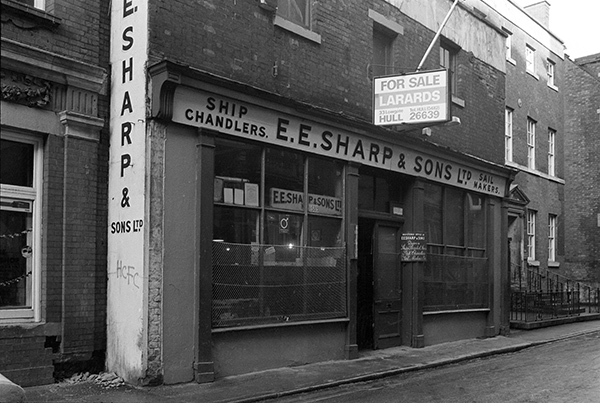
33h32: E E Sharp & Sons Ltd, Sail Makers & Ship Chandlers, High St, 1982 – Old Town
and a second picture taken at the same time:
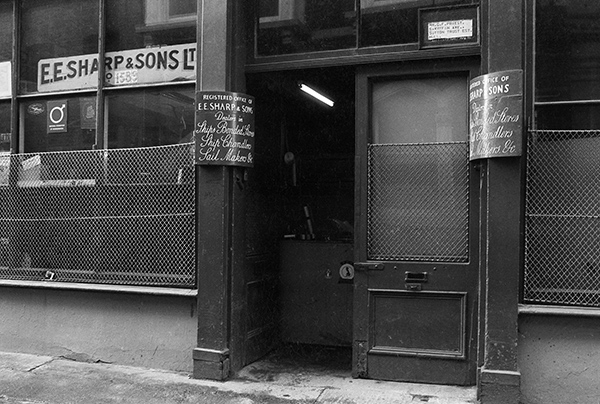
33h33: E E Sharp & Sons Ltd, Sail Makers & Ship Chandlers, High St, 1982 – Old Town
Four months later, in April 1983 I took a further picture of the same shop. The only apparent change was that the doors were now both closed.
11th June 2017
A pile of odds and ends from ship maintenance near the entrance to the Union Dry Dock was topped by a boat. Behind it the towers are those of Rank’s Blue Cross Animals Feed and others to the north of the main Clarence Mill buildings.
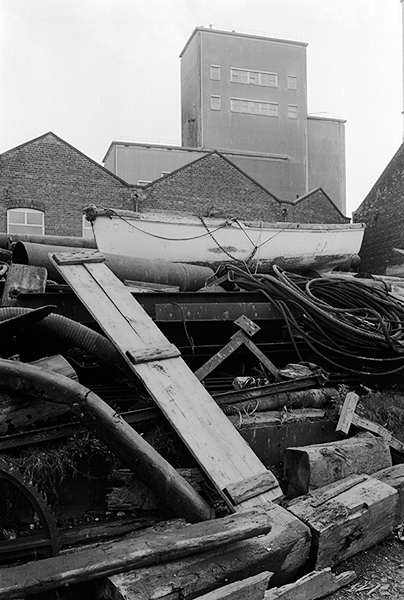
34g22: Union Dry Dock, Great Union St, 1983 – River Hull
12th June 2017
The Union Dry Dock on the east bank of the River Hull was full of water with no ship being worked on, its gates open to the River Hull and a rather solid looking bridge taking the riverside path across, though I think the path was still closed by various obstructions at this time.
On the other side of the river are buildings on Dock Office Row, as well as the large bulk of Hull College beyond. Past the chimney on the right is the crane, a Scotch Derrick, now one of Hull’s listed buildings and the shed of the Yorkshire Dry Dock Company on the west bank of the River Hull.
This dry dock is still there, though silted up, and with a rather fancier bridge across its entrance. The factory and chimney and the Yorkshire Dry Dock shed have gone, and the riverside between Drypool Bridge and Charlotte St stands empty and deserted, as if Hull has not found a way to incorporate its heritage into the city.
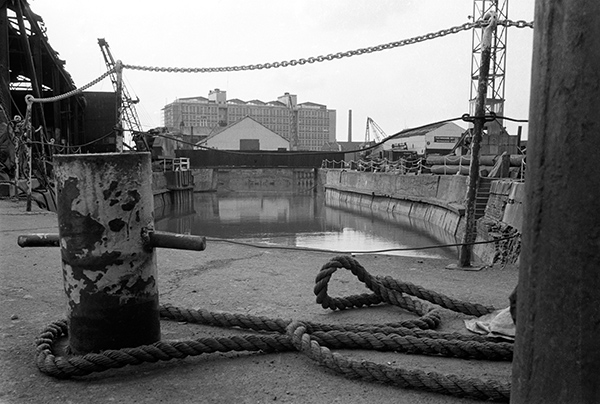
34g26: Union Dry Dock, Great Union St, 1983 – River Hull
13th June 2017
Chambers & Fargus, an edible oil refiner and seed crushing company, was founded in 1854 by Henry Waudby Chambers and James Fargus and was at High Flags Mill at 200 Wincolmlee few hundred yards upstream on the opposite side of the river from their factory on the left of this picture.
The High Flags area had formerly been part of Hull’s whale oil industry according to an article in the Hull Daily Mail about the possibility of their former mill there being converted in to riverside flats and High Flags Wharf got its name from large flagstones there to make it easier to handle the large barrels of whale oil landed there.
Chambers & Fargus imported linseed and rape from the Baltic to crush in hydraulic presses, producing oils for use in paint, linoleum, and other products and leaving ‘C & F Super Cake’ animal feed. Later soya became an important product for them.
In 1905 the firm was incorporated under the Companies Act 1862 as a private limited company. In 1907, two years later it purchased the former Anglo-Egyptian Oil Mills and Refinery in Lime street on the left of this picture, though most of this factory was rebuilt after a disastrous fire in 1937. The company went public in 1947 and was sold to the Swedish Karlshamns group in 1989. The factory is still there now, looking much the same as in 1983, and there were clouds of steam coming from it when I last went past.
The site is now owned by Finlays, part of an international company founded in Glasgow in 1750 trading with the British empire, particularly in cotton. It is now principally focused on tea but also coffee and other beverages, with “tea estates, extraction facilities for tea, coffee and plant extracts, packing facilities and R&D labs across four continents.”
The Humber Star was built in 1969 and was owned by John H Whittaker (Tankers) Ltd of Hull, an Oil Products Tanker of 274 tons gross, built at Harkers of Hull. In 2009 she was an effluent carrier owned by Oran Environmental Services and sank at her berth in Southampton. Later with name changed to Wade Stone she was detained elsewhere in Southampton in 2011 for multiple breaches of safety and was arrested in Malta in 2013 as Kara. This vessel appears now to have been scrapped.
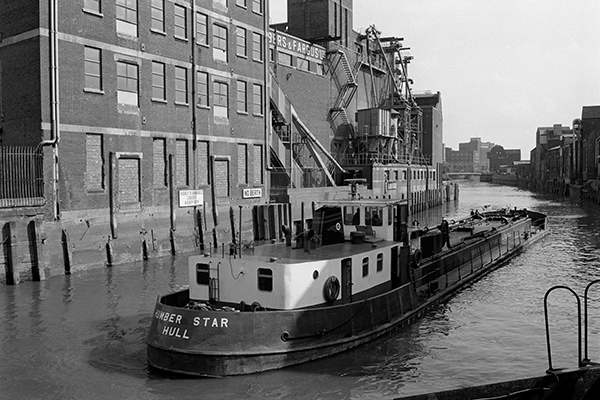
34g42: Humber Star on the River Hull from Scott St, 1983 – River Hull
14th June 2017
Two men share a few words with a member of crew as the Humber Star goes through Scott St Bridge, the flag of John H Whittaker (Tankers) Ltd clear on its funnel. The two men on the bridge are I think the bridge operators, with a small panel behind them with electrical cables leading off left. The two bascules of Scott St were raised by an electrically powered hydraulic system, which when first built was presumably linked to the nearby hydraulic power station, the first such public utility in the UK. The Grade II listed bridge has been held in raised position to road traffic for years and allowed to decay by Hull Council.
The vessel was actually going backwards upstream slowly on the tide, and I took four pictures as it approached and came through the bridge (this was the last), as well as one of the bridge opening before it arrived. The river here is too narrow for a vessel of this size to turn around.
At the wharf beyond is Bonby, empty and high in the water and waiting to be loaded with sand or gravel. Bonby is a village in North Lincolnshire a few miles south of Barton upon Humber.
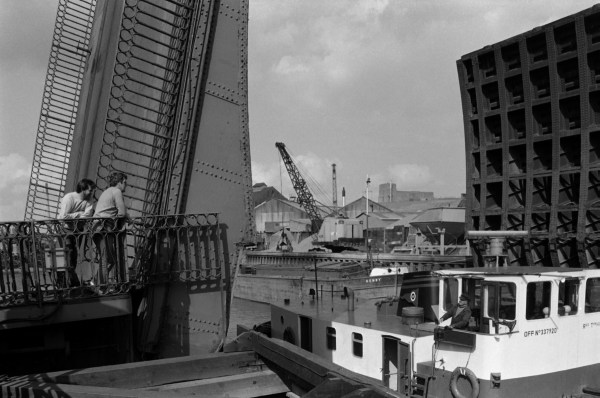
34g44: The Humber Star goes through Scott Street Bridge, 1983 – River Hull
You can see the new pictures added each day at Hull Photos, and I post them with the short comments above on Facebook.
Comments and corrections to captions are welcome here or on Facebook.
______________________________________________________
There are no adverts on this site and it receives no sponsorship, and I like to keep it that way. But it does take a considerable amount of my time and thought, and if you enjoy reading it, a small donation – perhaps the cost of a beer – would be appreciated.
My London Diary : Buildings of London : River Lea/Lee Valley : London’s Industrial Heritage
All photographs on this and my other sites, unless otherwise stated, are taken by and copyright of Peter Marshall, and are available for reproduction or can be bought as prints.
George Yard historically was actually to the south west of the warehouse shown, and it ran east from Lowgate. There was only a narrow pedestrian alley leading to High St. But when the street now known as Gandhi Way was developed it was given the name George Yard, despite being a short distance away from the original. Thanks to Danny Wood and Steward Would on the Hull:The good old days facebook group for clarifying this.
There is a highly detailed Insurance plan of the area in 1886 (one of 12 covering all of central Hull) for those who want details :
http://www.oldmapsonline.org/map/britishlibrary/mapsu145ubu13u1uf005r